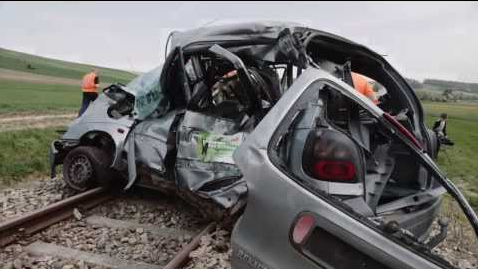Size Arrival Effect

The rate of very big things crushing much smaller things - like automobiles and humans - is at record highs.. This has some safety officials baffled. And I frequently hear "It's a train!" when there is news of a pedestrian or motorist being crushed by an 8,000 ton object moving through space on the exact same course it has followed for more than 100 years. Train horns are loud, louder than the loudest rock concert (125 decibels vs. 140 decibels). Yet people still get crushed.
There is one often overlooked contributor to the carnage. It is called the "Size Arrival Effect" and is the tendency of observers to underestimate the speed of larger objects. The "Size Arrival Effect" it is a bug in primate firmware. When you see two objects in motion you will feel that the smaller object is moving faster [and, thus, the larger object is moving slower]. Imagine a dirt bike racing an oncoming freight train - - - that glob of primordial neurological goo dangling from the bottom of your big human brain is always confident the dirt bike is going to win. Is this because gazelles are faster than elephants? That glob of goo did spend millennia being frustrated by the speed of the very delicious gazelle. Maybe, but it is inadvisable to let the glob of goo make wagers, especially in this instance.
It seems an odd flaw. Anyone who has taken a drawing or drafting class [is drafting still a thing?] knows how to draw a perspective. Nearer objects are larger and diminishing in size is proportional to receding into distance. That perspective is one of the principle mechanisms whereby our vision pretends to know about distance. Considering the perspective drawing one would assume that we primates would feel that the larger object is nearer and the smaller object further away. That would be the safest assumption. Personally, given only the two options, I would prefer to be struck by a motor bike than a freight train. Yet once you place the objects from that perspective in motion something in our neurology mixes this up, with potentially lethal consequences. It is, like so many truths about us humans, maddeningly counter-intuitive.
Size Arrival Effect is not the only component of this safety problem. Other studies have found that people do indeed exercise more conservative behavior in the presence of larger vehicles, be they tractor-trailers or trains. Something in the human upstairs does have a grasp on the inexorable physics of this situation. If someone is tired or distracted are those executive functions not at the ready to assert themselves and override the goo's misconception?
With more people, more trains, and more trucks . . . Nobody wants more deaths to be the inevitable consequence. Yet it is hard to come up with any straight-forward solutions for mixing our giant technological achievements with their fragile and glitchy creators.
The standard advice: "stop, look, listen" might need to upgraded to "stop, look, listen, take-a-breath-and-think".
The most memorable metaphor I have heard related to this issue:
Imagine striking a 16oz can of Coca Cola, at speed, with your automobile. The can is destroyed, your car is fine. Now do the math: You + Your Automobile are the equivalent to a 16oz can of Coca-Cola when struck by that 8,000 ton freight train. Don't be a can of Coke.
Its true, that math is spot-on.
P.S. Elephants have a top speed of ~25mp/h. The average human runner is ~15mp/h. Unless you are an Olympic athlete you cannot out run even something as large as an Elephant. Let the Elephant have the right-of-way.
References
Another name for the "Size Arrival Effect" is the "Size Speed Bias". These refer to, perhaps not the same, for very related concepts.
